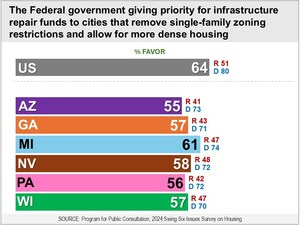Public Proposes Federal Budget Dramatically Different Than House or White House
COLLEGE PARK, Md., March 3, 2011 /PRNewswire-USNewswire/ -- An innovative study has found that when a representative sample of the American public was presented the federal budget, they proposed changes far different from those the Obama administration or the Republican-led House have proposed.
The biggest difference in spending is that the public favored deep cuts in defense spending, while the administration and the House propose modest increases. However, the public also favored more spending on job training, education, and pollution control than did either the administration or the House. On average the public made a net reduction of $146 billion--far more than either the administration or the House called for.
While there were some partisan differences in the magnitude of spending changes, in two out of three cases average Republicans, Democrats and independents agreed on which items should be cut or increased.
The public also showed readiness to increase taxes by an average of $292 billion--again, far more than either the administration or the House.
"Clearly both the administration and the Republican-led House are out of step with the public's values and priorities in regard to the budget," comments Steven Kull, director of the Program for Public Consultation (PPC), which conducted the study. PPC is a joint program of the Center on Policy Attitudes and the School of Public Policy at the University of Maryland. Unlike in conventional polls, PPC consults with the public by presenting respondents with information on policy issues and a range of options to address them. In this case respondents were presented the discretionary budget, with descriptions of each program, and allowed to make changes.
For this analysis the changes the public made in the budget exercise were compared to the OMB projected budget for 2015, while those the administration made were in its 2012 budget proposal relative to the previous year. Changes by the House were based on the recently-passed changes to spending for 2011. (2011 spending is lower than 2015 projections but the distributions are very similar; thus comparisons of percentage changes are meaningful.)
It was conducted using the web-enabled KnowledgePanel®, a probability-based panel designed to be representative of the U.S. population. More technical information is available at http://www.knowledgenetworks.com/ganp/reviewer-info.html.
SOURCE Program for Public Consultation
WANT YOUR COMPANY'S NEWS FEATURED ON PRNEWSWIRE.COM?
Newsrooms &
Influencers
Digital Media
Outlets
Journalists
Opted In






Share this article